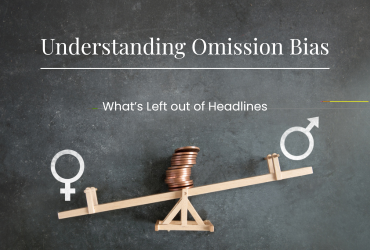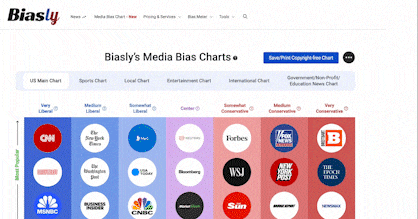
Have you ever had a gut feeling that you’re not getting all the important information in an article? Something telling you that there has to be more to this situation than what’s being told? Well, that gut feeling might be trying to warn you of bias.
Bias comes in many forms. Easily the most recognizable form of bias is the wording used by an article. They might use ‘riot’ to describe a protest they disagree with. A liberal source might cite a liberal think tank to justify their view. These articles, while still requiring effort to recognize, can be checked with brief fact-checking.
But some forms of Biases are not innately recognizable. They are deliberately deceitful, meant to deceive the reader into supporting something without all the relevant information. They don’t care for factual reporting or informing the reader, but rather for furthering their narratives. Among these hidden forms is Omission bias.
Omission bias occurs when a news source deliberately leaves out pieces of information to promote a particular narrative. It can come in many forms, from as little as leaving out a name to as large as leaving out an entire side of an argument. Omission can make an innocent event look horrible and a horrible event look innocent.
This type of bias is uniquely sinister. It stops the reader from forming their own beliefs, as it strips the situation of relevant information. Other forms of bias intend to manipulate the reader through subconscious suggestion. However, a perceptive reader might still catch glimpses of bias in those other forms. Omission only grants the viewer the information the article wants to give. This then stops the reader from forming accurate opinions, without them even knowing.
Omission bias is not accidental. Some articles may inadvertently omit information or be unaware of it. These are not examples of omission bias, but simply a sourcing and research issue. However, that is why recognizing Omission bias is so difficult; they can sometimes be explained simply as unintentional.
So, here comes the questions that need to be asked: What are the common forms of Omission bias? Why is Omission bias so difficult to recognize? What are some ways to counteract Omission bias?
For those answers, look no further than this article.
Common Forms of Omission Bias
Omission bias comes in many forms, some less recognizable than others. Some articles might omit opposition to a policy in the headline. Others might briefly, or not at all, talk about the opposing view on the policy. In this section, we will explore some of the most common forms of Omission Bias.
Headline Omission Bias
The first impression a reader on an article is the headline. Oftentimes, they will purposefully use flowery language to draw the reader’s attention in. Even more common, they will unabashedly mention how the opposing argument is unequivocally false. And, as it seems, that is commonly the reader’s only impression of the article.
According to a Pennsylvania State University article, social media users are unlikely to read past the headline of an article sent to them, let alone click on the link. Thus, omitting certain arguments from headlines can be a valuable tool for those trying to control the narrative.
Take, for example, this article from FOX News, which Biasly’s Media Bias Chart rated as ‘Very Right’. The article is headlined as “Dem Disorder: DNC squabbles play out in NYC mayoral race for all to see.” The headline tells of intense conflict in the Democratic National Committee. However, those who only read the headline might be led to believe that Mamdani was the sole catalyst for this discourse.
The headline implies that Zohran Mamdani’s primary win was the sole cause of the conflict. This may be an attempt to belittle the progressive movement in the DNC. This would go a long way to maintain the moderate Democrat dominance in the DNC. This dominance would then make the Democratic Party more open to right-leaning ideology, as opposed to the progressive Democrats.
Argument Omission Bias
Another form of Omission bias is argument omission, which occurs when an article leaves out important arguments. One might think that this simply involves leaving out the opposing argument altogether. That is certainly one way; however, the most common version includes very little of the argument.
Including very little of the argument can make the opposition seem incomplete. Doing so belittles the opposition and makes it seem like the proponent’s argument seem to be completely factual. The reader might have spotted a flaw in the opposition’s argument, and, believing the opposition didn’t think about the flaw, decides to support the other side. This could happen, even if the opposition had noticed and had fair reasoning for the flaw.
One such example of argument omission is this article by MSNBC, which Biasly’s Media Bias Chart rated as ‘Very Left. ’ The article primarily presents the opposing opinion of the Supreme Court case, quoting Supreme Court Justice Sonia Sotomayor. Sotomayor is notably a left-leaning Justice, having been chosen for the position by former Democratic President Barack Obama.
The article presents the Trump Administration’s argument for this ruling. However, it notably does not present the court’s majority ruling, which is problematic in two ways. Firstly, it gives a partisan view of the majority ruling. This is because the argument for the majority ruling is only displayed by the Trump Administration, essentially equating the majority ruling with the Trump Administration. Thus, it makes the readers believe that the justices who voted in the majority are simply voice pieces for Donald Trump.
Secondly, it does not let the readers see the exact words of the majority ruling. It doesn’t show the majority’s justification for the decision. This makes the court’s ruling abstract, and able to be manipulated into saying something it did not say. It doesn’t let the reader decide their opinion for their own opinion, and thus stops them from taking an informed stance.
Information Omission Bias
The last form of omission bias is information omission. This is similar to argument omission, as it leaves out critical details surrounding arguments. It carries many similar traits to argument omission. It leaves out critical information and does not give the reader a chance to form their own opinion. However, it differs because it’s not based on arguments, but rather information about the event in general.
One such example of information omission is this article by the New York Post, which Biasly’s Media Bias chart rated as ‘Medium Right’. The article provides information about a bill recently passed in the Senate that would provide funding cuts to programs. However, the article fails to go into immense detail on what exactly those cuts are. Sure, they mention broadly as cuts to the US Agency for International Development (USAID) and the Corporation for Public Broadcasting (CPB). But they provide little information on what exactly those cuts were.
Notably, the article only briefly mentions this lack of specificity. They do mention a quote from Senator Susan Collins (R-Maine), who claims that there were serious procedural concerns. However, they cut that quote short, and the section that includes that quote is only two lines long.
Leaving out information is detrimental to understanding situations. For bills, it can harm people from understanding what exactly is in the bill, as mentioned in the previously mentioned article. Leaving out this information does not allow the readers to make an informed stance on the topic.
Why Omission Bias is so Difficult to Recognize
Now that we have looked through different versions of Omission bias, let us pause briefly to explain why Omission bias is so difficult to recognize.
At the very core of Omission bias is a lack of knowledge. That, itself, is what makes Omission bias so difficult to recognize. After all, how can you recognize something you have no idea exists? If you don’t have any way of knowing it exists, you then have no way of knowing how to learn about it.
It’s a self-repeating cycle in which a news source can control what information is boosted and what information is omitted. Controlling that information can spread like a disease, because news sources often cite each other as sources for events. If a source covers a situation earlier than everybody else, it can essentially influence what is shared by other sources. Ultimately, it will make it difficult to spot the definitive origin of information, harming readers who like to do their research.
Omission leads to misinformation, which leads to bias. It takes either training to recognize when a story isn’t complete or instinct to fill in information gaps. It is undeniably a difficult task.
Ways to Recognize and Counter Omission Bias
Ultimately, it is up to the reader to spot omissions in articles. Here, we will give you some tools to help recognize and counter omission.
Using a plethora of sources when researching a topic is perhaps the strongest way of combating bias. Sources that oppose each other’s views will inherently want to disprove or draw attention to certain aspects of, say, a bill.
For example, a bill that sees strong support amongst the left will often have articles from left-leaning sources. These sources will draw attention to all the positives that would come from this bill. It might focus on the bipartisan support or appeal to the empathy of the reader. But, chances are, they will omit opposing arguments and potentially negative impacts of the bill, which is where other sources come in.
A right-leaning news source will try to draw attention to the bill as well. However, here they will focus on the negatives of the bill and the potential harmful repercussions. They will look at flawed sections in the bill and shed light on opposing opinions.
But, you may ask, what if you are still struggling with getting all the information possible? Well, that is when you turn towards ‘Center’ sources. These sources are often reputable and unbiased, and will give a mostly factual rundown of the bill. These sources generally don’t focus solely on the positives or the negatives, and give a balanced view.
As always, we recommend going to Biasly’s Media Bias Chart to see what source is ranked at which level of bias. We have a comprehensive list of sources and in which direction they are biased. We suggest looking at some articles surrounding a situation from the left, right, and center, so that you might get all the information possible.
It is always important to train yourself to recognize bias. While we strive to analyze as much bias as possible, we cannot always be there to help. We suggest looking through popular situations in politics today and seeing how each side covers them. Compare what information is readily available in these sources and what is lacking. Then you can train yourself to recognize patterns in omission bias, allowing you to instinctively recognize it in the future.
To support this learning process, you can also explore Biasly’s Media Literacy Education Platform (MLEP), which offers structured guidance through interactive lessons, case studies, and tools that help users evaluate news reliability, identify political leanings, and spot bias in real time.
But it’s all ultimately up to you, the reader. Bias prevails as long as you let it. Getting all the information relevant to a topic is instrumental to forming a fact-based opinion. We recognize everybody has bias in their own way; it’s nearly impossible to avoid. But acknowledging your bias, and that of the sources you read, can better train you to stay informed. Staying informed lets you take a knowledgeable stance.


























